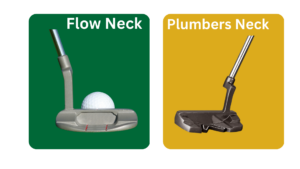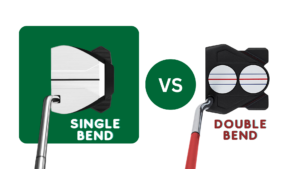
Do you want to become a scratch golfer? Or maybe you just want to improve your putting and lower your handicap. Either way, practicing your putting is essential to becoming a better golfer.
But what are the best putting drills to help you improve?
This article will give you an ultimate guide to the best putting drills out there. We’ll cover everything from basic stroke mechanics to more advanced drills to help you holed more putts under pressure.
So whether you’re a beginner or a seasoned pro, there’s something here for everyone. Let’s get started.
Basic Putting Stroke Drills
The first group of putting drills we’ll cover focuses on basic stroke mechanics. These are the sort of drills that you should be doing regularly regardless of your skill level.
1. The Ladder Drill

This is a great drill for getting a feel for the correct putting stroke. It also helps to promote a square impact position and encourages you to keep your putter face square through impact.
Here’s how it works:
- Place a ladder on the ground, ensuring that the rungs are evenly spaced apart.
- Start at the first rung and place the ball just outside the edge of the rung.
- From here, stroke the ball along the ladder, hitting each rung in turn.
- After you’ve reached the end of the ladder, start again from the beginning and continue until you’ve made 10 successful short putts in a row.
2. The Hinge Drill
This drill is designed to help you create the correct hinging action in your wrist during the stroke. It’s a great drill for developing feel and promoting a consistent putting stroke.
Here’s how it works:
- Place your putter behind the ball, so the shaft runs along your forearm.
- Now, holding your arms still, try to hinge your wrists up and down, ensuring that the putter face stays square to your intended target line.
- Do this 10-15 times, focusing on maintaining a smooth, consistent motion.
- Once you’ve got the hang of it, try doing the drill with the putter in your normal putting grip.
3. The 1-2-3 Putting Drill

This drill is a great way to ingrain the correct stroke path into your muscle memory. It’s also a good way to ensure that you’re making consistent contact with the ball.
Here’s how it works:
- Place three golf balls in a line, spaced around a foot apart.
- Starting with the ball on the left, make a putt and try to get the ball to finish as close to the hole as possible.
- Once you’ve made your putt, move on to the next ball and repeat the process.
- Try to make 10 successful putts before moving on to the next drill.
4. One-Handed Putting Drill (Block Practice)
This is one of the best drills for improving your basic putting stroke. All you need is a single golf ball and a putter.
- Simply set up the ball so that it is in line with your target.
- Take your normal stance and grip, but only use your dominant hand to hold the putter.
- From here, make some practice strokes without hitting the ball. Once you are comfortable, take your shot.
- The key is to focus on making a smooth, even stroke while keeping your wrist firm. Try to hit the ball in the center of the putter’s face to ensure solid contact.
After each successful putt, reset the ball and repeat the drill until you have made 10 in a row from approximately 3 feet. Once you can consistently make putts from this short-range, move back to 5 feet, then 7 feet, and so on.
5. Phil’s Circle Drill
This putting drill was created by one of the game’s greats, Phil Mickelson. It is designed to help you improve your aim and stroke accuracy. You will need at least two golf balls for this drill.
- Start by drawing a circle around the hole approximately 3 feet in diameter.
- Then, set up your putt, so the ball is just outside the circle.
- Take your shot, trying to land the ball inside the circle.
- If you are successful, reset the ball and take another shot. If you miss the circle, retrieve your ball and try again.
- After 10 successful putts, move back to 5 feet, then 7 feet, and so on. The further away you get, the more challenging the drill becomes.
6. In a Line Short Putting Drill

This is another great drill for improving your aim and accuracy. You will need at least five golf balls for this one.
- Start by setting up a putt from approximately 3 feet away.
- Then, place two additional balls directly in the same line with the first ball and your target (one behind the other).
- Take your shot, trying to hit all balls in succession. If you are successful, reset the balls and try again.
If you miss any balls, retrieve them and try again. After 10 successful putts, move back to 5 feet, then 7 feet, and so on.
7. Clock Putting Drill
This clock drill is designed to help you improve your aim. Start by placing the hole in the center of an imaginary clock face. Then, set up your ball to be at the 12 o’clock position (directly in front of the hole). Take your shot, trying to hit the ball into the hole. If you are successful, reset the ball and take another shot from the 3 o’clock position (to the right of the hole).
Continue taking shots from different positions around the clock face until you have made 10 in a row. Once you have mastered this drill, try it from different distances to further challenge yourself.
8. Alignment Rod Putting Drill
This drill is designed to help you improve your aim and alignment. You will need an alignment rod or dowel for this one.
Start by setting up a putt from approximately 3 feet away. Then, place the alignment rod so that it is parallel to your target line (running through the hole).
Take your shot, trying to hit the ball through the “gap” created by the alignment rod. If you are successful, reset the ball and try again. If you miss, simply retrieve your ball and try again.
You can also use this drill to work on your speed control. Simply place the alignment rod closer or further away from the hole to adjust the difficulty of the drill.
9. Lag Putting Drills
This drill is designed to help you improve your distance control. Start by setting up a putt from approximately 10 feet away. Then, take your shot, trying to hit the ball close to the hole without going in. If you are successful, reset the ball and try again. If you miss, simply retrieve your ball and try again.
After 10 successful putts, move back to 15 feet, then 20 feet, and so on. The further away you get, the more challenging the drill becomes.
Putting is an important part of the game of golf, and these drills can help you improve your skills. Practice them often, and you’ll be sinking putts in no time!

Before the Round Putting Drills
Some warm-up putting drills can do wonders for your game. They can help improve your distance control, make the 3-footers easier, and give you a better feel for those 20 to 30-footers. Here are some of the best putting drills to try out next time you’re on the green:
1. Putt To Fringe to Warm Up Distance Control
The first drill is simple but effective. Find a spot on the fringe about 10-15 feet from the hole. Using a putter, aim to hit the ball, have it roll over the fringe, and stop as close to the hole as possible.
The goal is to get a feel for your distance control and learn how to gauge your speed. Do this drill a few times until you get a consistent result.
It’s also a good idea to vary the distance from the hole. Try hitting the ball from different distances to see how it affects your speed and accuracy.
2. Drain the 3-Footers
This great putting drill is all about mastering those pesky 3-foot putts. Find a spot on the green where you can set up several balls in a row, about 3 feet from the hole.
Start by lining up your first putt and giving yourself a specific target to hit. It could be a spot on the green or an imaginary line.
Focus on your stroke and aim to hit the target with each putt. If you make the putt, great! Move on to the next one. If you miss, reset and try again. The goal is to make as many putts in a row as possible.
3. Putt to a Tee for 20-30 Footers
This drill will help you improve your accuracy on longer putts. Find a spot on the green where you can set up several balls in a row, about 20-30 feet from the hole. Place a tee in the ground at each ball’s position.
Again, choose a specific target to hit with each putt and focus on your stroke. The tee will help you maintain a consistent distance from the ball, which will, in turn, help improve your accuracy. Try to make as many putts in a row as possible.
These putting drills will help get your game in top shape so you can start sinking those putts easily. Practice makes perfect, so head to the putting green often and work on your game. With a little effort, you’ll see a huge improvement in your putting skills.

FAQs
1. How Can I Improve My Putting Skills?
There is no magic answer when it comes to improving your putting skills. However, there are a few key things that you can do to help improve your game.
- First, be sure to practice regularly. The more you practice, the better you will become at making those crucial putts.
- Also, pay attention to your form and technique. Make sure you use a smooth, consistent stroke and aim for a spot just above the hole.
- Finally, don’t get too caught up in the result of each putt. Just focus on making a good stroke, and the results will care for themselves.
2. What Is the Best Way to Practice Putting?
The best way to practice putting is to find a spot on the green and set up a few golf balls in a row. Then, take your time and focus on making a good stroke on each putt. Try to keep your form consistent and pay attention to your aim.
After making a few putts, move back a few feet and repeat the process. This will help you feel for different distances and improve your accuracy.
3. What Are Some Common Putting Mistakes?
One of the most common putting mistakes is failing to line up correctly. Be sure to take your time and line up each putt carefully. Another common mistake is rushing your stroke. Try to stay relaxed and take your time when making each putt. Rushing will only lead to inconsistency, and more missed putts.
Finally, many golfers make the mistake of overthinking their putts. Just relax and trust your aim and stroke. Overthinking will only lead to more frustration and missed putts.
4. What Is the Best Putter for Beginners?
There is no one “best” putter for beginners. Finding a putter that feels comfortable in your hands and suits your playing style is important.
If you are unsure of what kind of putter to purchase, ask a golf professional or someone at your local golf shop for help. They will be able to recommend a putter that is right for you.
Conclusion
Putting drills are an excellent way to improve your putting skills and technique. By practicing various putts from different distances and speeds, you can learn how to control the ball better and become a more consistent putter.
There are many different putting drills that you can try, so experiment with a few to find which ones work best for you. Remember to focus on your form and alignment, and don’t get discouraged if you don’t see results immediately – it takes time and practice to master the art of putting!






